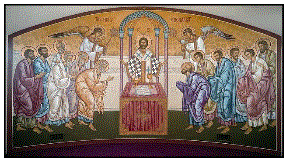 As I shared in the last issue of this article, we have a glimpse of how early Christians worshipped from the eighth book of the Apostolic Constitutions. It contains the earliest complete text of a eucharistic rite and represents the usage of the Church of Antioch. The number of resemblances between that rite and the developed Byzantine Divine Liturgy, is striking. The earliest surviving texts we have of the developed Byzantine Divine Liturgy dates from the end of the eighth century or the beginning of the ninth.
As I shared in the last issue of this article, we have a glimpse of how early Christians worshipped from the eighth book of the Apostolic Constitutions. It contains the earliest complete text of a eucharistic rite and represents the usage of the Church of Antioch. The number of resemblances between that rite and the developed Byzantine Divine Liturgy, is striking. The earliest surviving texts we have of the developed Byzantine Divine Liturgy dates from the end of the eighth century or the beginning of the ninth.
The following is a description of the eucharistic ritual used in Antioch. It is contained in the Apostolic Constitutions.
The congregation gathered in a church that was pointed towards the east, rectangular in shape and with sacristies (i.e., those rooms used for clergy and servers to vest) on either side at the east. The people were carefully segregated. Men sat on one side and women on the other. Only the elderly and very young had seats. Deacons made sure that people were in their proper places.
The Liturgy began after the vesting of the bishop and his enthronement. There were readings from the scriptures during this portion of the service. It seems that readings were taken from both the Old and New Testaments: the Torah, the Prophets, the Epistles, the Acts and the Gospels. It is not clear, however, whether passages from each were read on every occasion. The rubrics (i.e., liturgical directions) directed the readers to stand on some high place in the middle of the nave. The Psalms of David were also sung between the readings. Sermons by the bishop and priests followed when the readings were completed. The bishop always preached while sitting (This is clearly seen when the Patriarch of Rome, the Pope, preaches). It should be noted that in the early Church, all communities had a man appointed as a bishop. The Liturgy was never served only by a priest.
Following the sermon(s), all people who were not baptized and, therefore, permitted to receive Holy Communion, were dismissed. They were dismissed right before the recitation of the Creed which was the secret profession of what Christians believe. Until more recent years, the following was said before the recitation of the Creed: The doors, the doors. In wisdom let us be attentive. Since we no longer dismiss people who attend the Liturgy, we have dropped those words about the “doors”.
It was only when the baptized faithful were left in the Church did the Liturgy continue. It was only after the Creed was recited (this is still true), that the actual Anaphora was then celebrated.
The Anaphora is the core of our worship.
